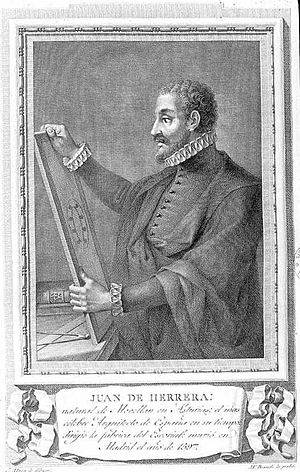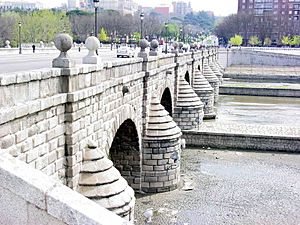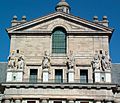Juan de Herrera facts for kids
Quick facts for kids
Juan de Herrera
|
|
|---|---|
 |
|
| Born | 1530 |
| Died | 15 January 1597 |
| Alma mater | University of Valladolid |
| Occupation | Architect |
| Buildings | El Escorial Royal Palace of Aranjuez Valladolid Cathedral |
Juan de Herrera (born 1530, died 1597) was a famous Spanish architect. He was also a mathematician and a geometrician (someone who studies shapes).
He was one of the most important Spanish architects in the 1500s. His work showed the best of the Spanish Renaissance. This was a time when art, learning, and new ideas were very important in Spain.
Herrera's simple and grand style is seen in buildings like the Monastery of El Escorial. A special building style, called the Herrerian style, was named after him. This style was very popular during the time of King Philip II of Spain.
Juan de Herrera loved learning about many things. He wrote a book called Discurso sobre la figura cúbica. This book showed his great knowledge of geometry and mathematics. He also traveled with Emperor Charles V during military trips. He visited places like Germany, Flanders, and Italy.
Contents
Juan de Herrera's Life and Work
Juan de Herrera began his career as an architect in 1561. His first big project was the Royal Palace of Aranjuez. In 1562, he also drew pictures for a book about astronomy. It was called The Book of Astronomical Knowledge.
Working on El Escorial
In 1563, Herrera started working on the huge Monastery of El Escorial. He worked under another architect named Juan Bautista de Toledo. When de Toledo died in 1567, Herrera became the main architect.
He made the plans for El Escorial even bigger. He designed the impressive front of the building. He also built the main church (Basilica) and the "Court of the Evangelists." Herrera also changed how the building was made and its roof.
The Herrerian Style
Herrera changed the look of the buildings at El Escorial. He used his own simple and grand style. This was exactly what King Philip II wanted.
His design focused on a large, flat look. He used bare granite stone for big areas. He did not use many fancy decorations. This style became known as the Herrerian style. It influenced Spanish buildings for over 100 years.
Other Famous Buildings
Juan de Herrera designed many other important buildings. These include the Valladolid Cathedral and the building for the Archivo General de Indias in Seville. This building now holds many old documents about Spain's history. He also designed the original plan for the Plaza Mayor in Madrid. This is a famous public square.
After he died, his tomb was moved from Madrid. It is now in the Church of San Juan Bautista in Maliaño, Cantabria. This was done as he asked in his will.
Main Projects by Juan de Herrera
Here are some of the most important buildings and projects designed by Juan de Herrera:

- Royal Palace of Aranjuez (started 1561)
- El Escorial (started 1563)
- Palacio de El Quexigal (1563) - This building no longer exists. It was in Robledo de Chavela.
- South side of the Alcázar de Toledo (1571–1585)
- Casa Consistorial de Toledo (1575) - This is Toledo's city hall.
- Puente de Segovia in Madrid (1582–1584) - A bridge in Madrid.
- Design for the Lonja de Sevilla (1583) - This is now the Archivo de Indias.
- Valladolid Cathedral (started 1589)
- Real Aposento de Torrelodones (1589) - This building no longer exists. It was in Torrelodones.
- Puerta de Triana (1588) - One of the gates of the Walls of Seville. It was later taken down.
Gallery
-
The Archivo de Indias in Seville.
See also
 In Spanish: Juan de Herrera para niños
In Spanish: Juan de Herrera para niños










